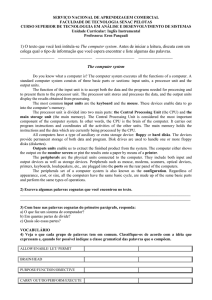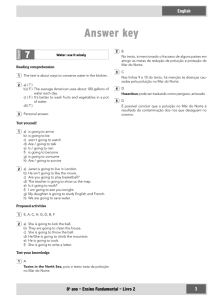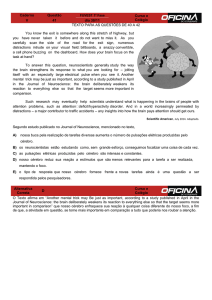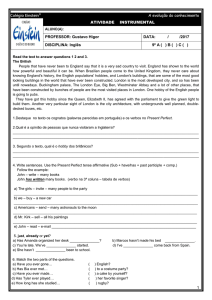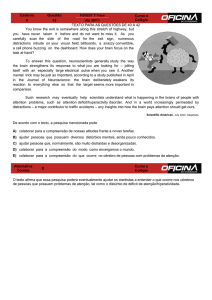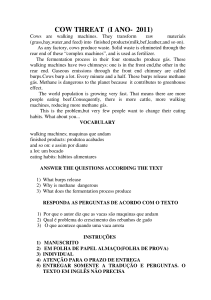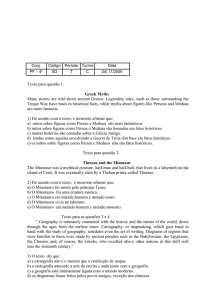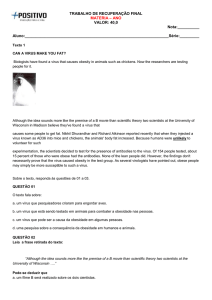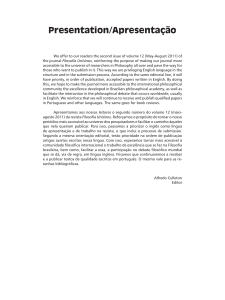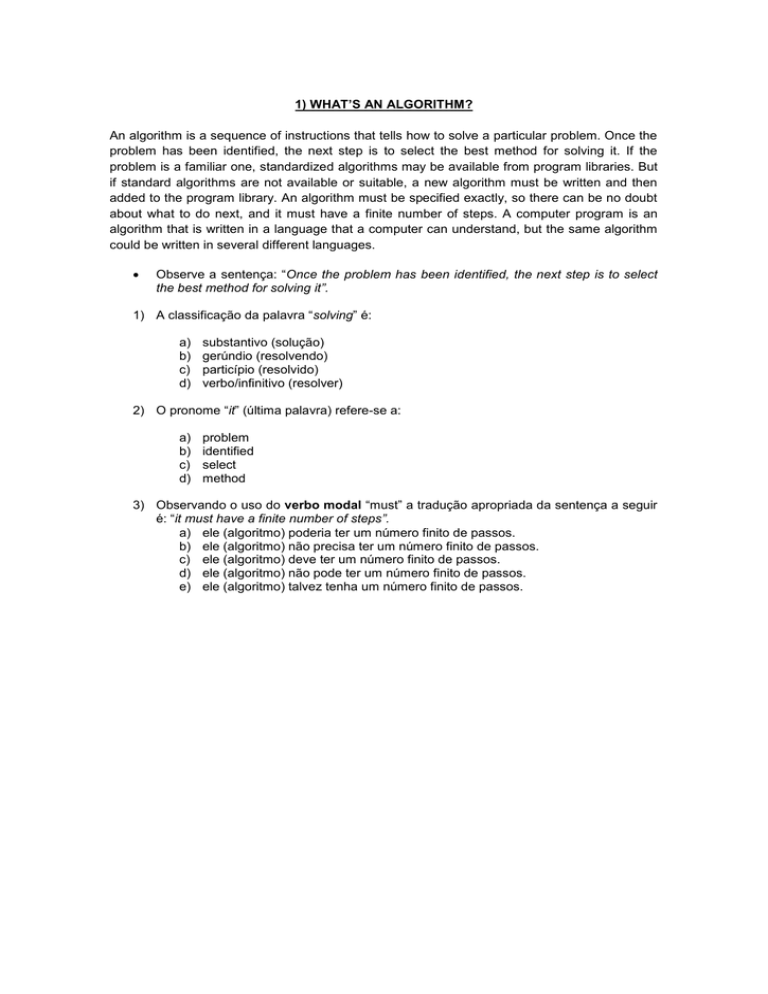
1) WHAT’S AN ALGORITHM?
An algorithm is a sequence of instructions that tells how to solve a particular problem. Once the
problem has been identified, the next step is to select the best method for solving it. If the
problem is a familiar one, standardized algorithms may be available from program libraries. But
if standard algorithms are not available or suitable, a new algorithm must be written and then
added to the program library. An algorithm must be specified exactly, so there can be no doubt
about what to do next, and it must have a finite number of steps. A computer program is an
algorithm that is written in a language that a computer can understand, but the same algorithm
could be written in several different languages.
Observe a sentença: “Once the problem has been identified, the next step is to select
the best method for solving it”.
1) A classificação da palavra “solving” é:
a)
b)
c)
d)
substantivo (solução)
gerúndio (resolvendo)
particípio (resolvido)
verbo/infinitivo (resolver)
2) O pronome “it” (última palavra) refere-se a:
a)
b)
c)
d)
problem
identified
select
method
3) Observando o uso do verbo modal “must” a tradução apropriada da sentença a seguir
é: “it must have a finite number of steps”.
a) ele (algoritmo) poderia ter um número finito de passos.
b) ele (algoritmo) não precisa ter um número finito de passos.
c) ele (algoritmo) deve ter um número finito de passos.
d) ele (algoritmo) não pode ter um número finito de passos.
e) ele (algoritmo) talvez tenha um número finito de passos.
2) MAGNETIC TAPE AND MAGNETIC DISK
Magnetic tape – it is one of the principal input/output recording media used with computers and
is mainly used for storing intermediate results of computations and for compact storing of large
amounts of data, in an ordered sequence. It is much cheaper to store information on tape than
in the computer main memory or on a disk memory device, but it takes longer to locate a
particular data item if it is stored on tape: data must be stored and accessed sequentially.
Magnetic disk – it consists of a series of concentric paths or tracks each capable of storing
data in magnetically coded form. It looks like a phonograph record and a series of disks is
mounted on a vertical shaft. One or more access arms move into the disk to read or write the
data stored on it. Disks may be hard (made out of aluminum) or floppy (made out of plastic).
Disks may be permanently attached to the drive unit or they may be made up as removable disk
packs. Disks may be made even more efficient by using laser beam to read and write data.
As questões 1 e 2 devem ser respondidas em Português.
1) Qual é a definição, conforme o texto, de Disco Magnético?
2) Quais são os dois principais usos das Fitas Magnéticas?
3) Indique a ordem em que essas idéias ocorrem no texto: Magnetic Disk
( ) disks may be hard or floppy.
( ) disks may be more efficient.
(1 ) disks consists of a series of concentric paths.
( ) disks may be made up as removable disk packs.
( ) disks may be mounted on a vertical shaft.
( ) disks may be permanently attached to the drive unit.
4) Indique se as afirmações são verdadeiras (V) ou falsas (F):
a) Magnetic tape is the only way for inputting data.
b) It is used for storing data sequentially.
c) It is much cheaper to store data on disks.
d) It takes longer to locate data stored on tapes.
e) Data on tape is stored in an ordered sequence.
(
(
(
(
(
)
)
)
)
)
5) Indique os dois erros do Presente Simples com círculos e dê as formas verbais corretas:
“Some mail systems uses a large disk space, but they doesn´t determine any amount before its
use.”
Formas corretas: a) _________________
b) ___________________
6) Observe o segmento abaixo:
“Magnetic Tape is mainly used for storing(1) intermediate results of computations and for
compact storing(2) of large amounts of data.”
A palavra storing (1) significa:
a)
b)
c)
d)
armazenar
armazenando
armazenamento
armazenado
A palavra storing (2) significa:
a) armazenar
b) armazenando
c) armazenamento
d) armazenado
3) COMPUTERS: START POINT
A computer is a machine capable of executing computations on data. The distinguishing feature
of a computer is its ability to store its own instructions and to performance thousands of
operations each second.
The Abacus, on which information is stored by moving beads along rods, was one of the earliest
calculating devices. Blaise Pascal developed an adding machine in 1642 that used toothed
wheel to handle carries from on digit to the next. Charles Babbage developed the concept of a
stored program computer when he designed a calculating engine in 1833.
The first electronic digital computer was ENIAC (Electronic Numerical Integrator and
Calculator), which was built for the U.S. Army in 1945. In the same year John Von Neumann
introduced the modern concept of a stores program computer, in which the computer memory
can store both programs and data.
Since then computer technology has developed very much.
(Adaptado de Galante, Inglês básico para informática,1992, p.9)
Responda às questões de acordo com o texto:
1) Quem desenhou uma máquina calculadora e em que ano?
2) Qual foi o primeiro computador eletrônico digital e em que ano foi construído?
3) Ligue as colunas de acordo com a tradução.
Dados
Teclado
Disquete
Disco rígido
Memória
(
(
(
(
(
) Hard disk
) Floppy disk
) Data
) Memory
) Keyboard
4) Coloque verdadeiro (V) ou falso (F): No grupo nominal
podemos afirmar que:
a) computer e digital são modificadores
b) electronic e digital são modificadores
c) electronic e computer são modificadores
d) computer é o núcleo
e) electronic é o núcleo
(
(
(
(
(
“electronic digital computer”
)
)
)
)
)
5) Escreva um breve resumo relatando sobre o que trata o texto.
6) Retire do texto cinco (05) palavras cognatas com tradução:
7) Retire do texto um (01) falso cognato e sua tradução.
8) Assinale abaixo, o único facilitador e/ou estratégia que NÃO foi utilizada na leitura do texto.
Dicas tipográficas;
Cognatos e palavras familiares;
Scanning;
Skimming;
Conhecimento de mundo.
4) SOFTWARE PIRACY
Software piracy is the unauthorized and illegal duplication of copyrighted computer software.
The most common forms include copying for personal use, for use among employees of a
company, and for resale. The latter includes manufacturing of counterfeit packages that pretend
to be originals.
Piracy is the most widespread computer crime. The Software Publishers Association (SPA), the
principal trade group of the personal computing software industry, estimated that in 1994 the
industry lost $8.08 billion worldwide due to illegal copying of operating systems, education,
entertainment, or personal productivity software.
(Excerpted from The 1996 Grolier Multimedia Encyclopedia.
1995 Grolier Incorporated. All rights reserved.)
Questões sobre o texto:
1. Quais foram todos os tipos de pirataria mencionados no texto?
2. De acordo com o texto, a pirataria é considerada um crime? Retire do texto a sentença que
afirma ou nega isso?
3) O que é a SPA? O que esta sigla significa?
4) Observe a palavra grifada: “The latter includes the manufacturing of counterfeit packages
that pretend to be originals.” Ela é um cognato ou um falso-cognato? Qual o seu real
significado?
5) PRINTING CONCEPTS
When users print, the computer completes several steps that involve a set of components
including executable files, drivers, device interfaces, and dynamic-link libraries, which work
together to create the printed output. Understanding how this process works helps you
understand what happens when you print a document and how to solve printing problems.
Printing has two parts: printing process and the print components. The two parts make the
printing process possible. When printing to an Internet print server, the print server adds to the
standard print process by creating an interface for users.
Após a leitura do texto responda as questões a seguir:
a) Sobre o que trata o texto?
b) Quais são as duas partes da impressora?
c) O que estas partes possibilitam?
d) Qual e o conjunto de componentes citados no texto?
e) O que o servidor de impressão adiciona quando imprime para um servidor de impressão
de Internet?
2) Localize as palavras familiares no texto acima e dê a tradução.
3) Circule todas as palavras cognatas.
6) JAVA
Who is the champion in the world about plataforms! If you said windows, you’re wrong. The
champion in technology is Java. It was created by “sun” to work in receptors of cable TV,
adapted for Internet and later to PDAs, cell phones and similars.
Java is a program language. Softwares that are writen in this “language” can be executed in any
dispositive, since it has the operational system.
This independence is possible due to the fact that this technology is based in a complex
software that permits to execute any order.
The name arose from a conversation among programmers in a coffee shop – Java is one kind
of coffee from Java island. From the name, others have arisen at the same time: Java beans –
Hot Java- only to exemplify. The stylistic cup is the famous reference. And there is one thing
that only programmers know. The first four bytes of any file class are in hexadecimal,
OXCAFEBABE.
Finally, about micro Edition, we have Java me, more known as Jame.
Java logo (created by sun)
(adapted from Internet Magazine, by Niuza Barone Peres, June, 2006)
1. Who is the champion in technology?
2. What is Java?
3. Como surgiu a marca e aonde?
4. Em que esta tecnologia é baseada?
5. Circule os Cognatos e relacione as familiares encontradas no texto.
6. Qual empresa criou a tecnologia mencionada no texto?
7) STORING DATA IN COMPUTER PROGRAMS
For those new to computer programming, data and code go hand in hand. You cannot write a
program of any real value without lines of code, or without data. A Word Processor program has
logic that takes what the user types and stores it in data. It also uses data to control how it
stores and formats what the user types and clicks.
Data is stored in the memory of the computer when the program runs (it can also be stored in a
file, but that is another matter beyond the scope of this tutorial). Each memory 'slot' is identified
by a name that the programmer chooses. For example LineTotal might be used to name a
memory slot that holds the total number of lines in a Word Processor document.
The program can freely read from and write to this memory slot. This kind of data is called a
Variable. It can contain data such as a number or text. Sometimes, we may have data that we
do not want to change. For example, the maximum number of lines that the Word Processor
can handle. When we give a name to such data, we also give it its permanent value. These are
called constants.
Responda:
1) Retire do texto todos os grupos nominais que conseguir identificar. (traduza-os)
2) Explique o que tem um programa processador de palavras e o que ele faz..
3) Que nome é dado ao tipo de dado que o programa pode ler livremente e escrever para a
memória slot?
4) Explique como pode ser usada a LineTotal.
5) Qual é a correta tradução do título do texto?
a) Dados armazenados em programas de computador
b) Armazenamento de dados em programas de computador.
c) Programas de computador em armazenamento de dados
6) Complete a tradução da frase. “Data is stored in the memory of the computer when the
program runs”
Dado é ______________ na ___________ do computador ___________o programa
_________.


